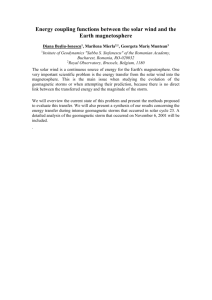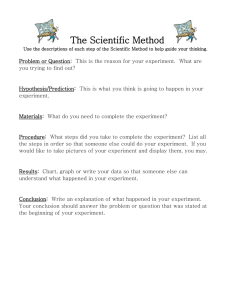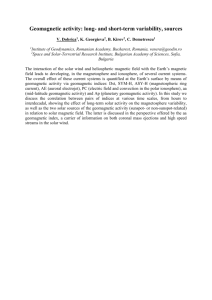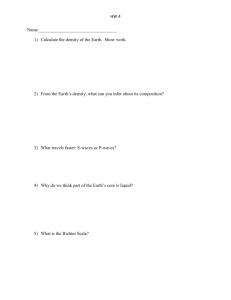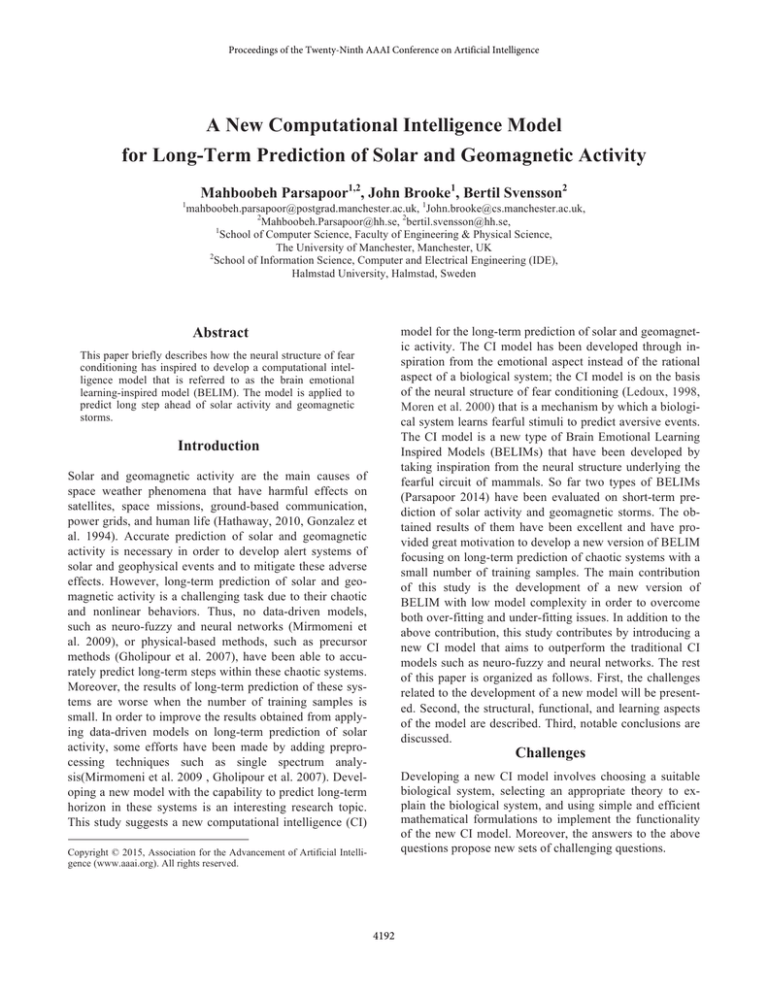
Proceedings of the Twenty-Ninth AAAI Conference on Artificial Intelligence
A New Computational Intelligence Model
for Long-Term Prediction of Solar and Geomagnetic Activity
1
Mahboobeh Parsapoor1,2, John Brooke1, Bertil Svensson2
mahboobeh.parsapoor@postgrad.manchester.ac.uk, 1John.brooke@cs.manchester.ac.uk,
2
Mahboobeh.Parsapoor@hh.se, 2bertil.svensson@hh.se,
1
School of Computer Science, Faculty of Engineering & Physical Science,
The University of Manchester, Manchester, UK
2
School of Information Science, Computer and Electrical Engineering (IDE),
Halmstad University, Halmstad, Sweden
Abstract
model for the long-term prediction of solar and geomagnetic activity. The CI model has been developed through inspiration from the emotional aspect instead of the rational
aspect of a biological system; the CI model is on the basis
of the neural structure of fear conditioning (Ledoux, 1998,
Moren et al. 2000) that is a mechanism by which a biological system learns fearful stimuli to predict aversive events.
The CI model is a new type of Brain Emotional Learning
Inspired Models (BELIMs) that have been developed by
taking inspiration from the neural structure underlying the
fearful circuit of mammals. So far two types of BELIMs
(Parsapoor 2014) have been evaluated on short-term prediction of solar activity and geomagnetic storms. The obtained results of them have been excellent and have provided great motivation to develop a new version of BELIM
focusing on long-term prediction of chaotic systems with a
small number of training samples. The main contribution
of this study is the development of a new version of
BELIM with low model complexity in order to overcome
both over-fitting and under-fitting issues. In addition to the
above contribution, this study contributes by introducing a
new CI model that aims to outperform the traditional CI
models such as neuro-fuzzy and neural networks. The rest
of this paper is organized as follows. First, the challenges
related to the development of a new model will be presented. Second, the structural, functional, and learning aspects
of the model are described. Third, notable conclusions are
discussed.
This paper briefly describes how the neural structure of fear
conditioning has inspired to develop a computational intelligence model that is referred to as the brain emotional
learning-inspired model (BELIM). The model is applied to
predict long step ahead of solar activity and geomagnetic
storms.
Introduction
Solar and geomagnetic activity are the main causes of
space weather phenomena that have harmful effects on
satellites, space missions, ground-based communication,
power grids, and human life (Hathaway, 2010, Gonzalez et
al. 1994). Accurate prediction of solar and geomagnetic
activity is necessary in order to develop alert systems of
solar and geophysical events and to mitigate these adverse
effects. However, long-term prediction of solar and geomagnetic activity is a challenging task due to their chaotic
and nonlinear behaviors. Thus, no data-driven models,
such as neuro-fuzzy and neural networks (Mirmomeni et
al. 2009), or physical-based methods, such as precursor
methods (Gholipour et al. 2007), have been able to accurately predict long-term steps within these chaotic systems.
Moreover, the results of long-term prediction of these systems are worse when the number of training samples is
small. In order to improve the results obtained from applying data-driven models on long-term prediction of solar
activity, some efforts have been made by adding preprocessing techniques such as single spectrum analysis(Mirmomeni et al. 2009 , Gholipour et al. 2007). Developing a new model with the capability to predict long-term
horizon in these systems is an interesting research topic.
This study suggests a new computational intelligence (CI)
Challenges
Developing a new CI model involves choosing a suitable
biological system, selecting an appropriate theory to explain the biological system, and using simple and efficient
mathematical formulations to implement the functionality
of the new CI model. Moreover, the answers to the above
questions propose new sets of challenging questions.
Copyright © 2015, Association for the Advancement of Artificial Intelligence (www.aaai.org). All rights reserved.
4192
ORBI
CX
poinput
sinput
MO
i
i
i
AGG
thinput
⎧
⎫
= ⎪
⎨ input,1,..., input,R ⎪
⎬
input
⎪
⎪
⎪
⎪
⎩
⎭
Input Vector
roinput
ro input
peainput
AGG
BL
p
a, j
painput
th
MAX _ MIN
input
rf
CM
Ouput
rainput
MAX_MIN
TH
LO
AMYG
Figure.1. The structural aspect of BELIM.
rinput
Functional and Learning Aspects of CI Model
For example, choosing the emotional system as a biological system to develop a new CI model proposes the question of which emotional theory should be considered to
explain the emotional system. This study considers the
conditioning theory of fear that proposes a neural structure
of the fearful circuit in mammals. However, considering
the neural structure of fear for developing the general
structure of the new CI model raises other questions.
The function of the CI model is implemented by assigning
different adaptive networks to different parts of the model.
In this study, the functions of the ORBI and the AMYG
will be implemented by assigning weighted-k nearest
neighbour-based adaptive networks (Parsapoor et al 2014).
Note that a W-kNN based adaptive network is simple with
low model complexity; thus it could be useful for the suggested CI model. The suggested CI model uses the combination of two learning methods, Steepest Descent (SD) and
Least Square Estimator (LSE), to update the linear and
nonlinear learning parameters.
New Computational Intelligence Model
The CI model can be described according to its structural,
functional, and learning aspects.
Structural Aspect of CI Model
Discussion and Conclusion
Figure 1 describes the structure of a BELIM that consists
of four main parts, the THalamus (TH), the sensory CorteX
(CX), the AMYGdala (AMYG) and the ORBItofrontal
cortex (ORBI). The internal structure of each component
and its connections have been summarized as the following. Let us assume that an input of i input from the training
Nu
(
indicate the number of training
data set {i input }input
= 1 Nu
data samples) is entered into the model, the input and
structure of each part have been explained in the following.
1) The TH, which consists of two subparts:MAX_MIN
(maximum_minimum) and AGG (aggregation) is the first
part of the model that receives i input . The TH provides two
Max _ Min
AGG
and thinput that are sent to the AMYG and
outputs thinput
the CX, respectively. 2) The CX provides sinput as an output and sends it to both the AMYG and the ORBI. 3) The
AMYG, is divided into the BL (corresponds to the set of
the Basal and Lateral of the amygdala) and CM (corresponds to the set of accessory basal and centromedial of
Max _ Min
and sinput
the amygdala). The AMYG receives thinput
and the expected
and provides e the primary output r
a input
punishment p a input . The latter is sent to the ORBI (the subscript a has been used to show the output of the AMYG).
4) The ORBI consists of the MO (medial of orbitofrontal)
and LO (lateral of orbitofrontal). The ORBI has a bidirec
tional connection
to the AMYG and receives
e
sinput and p a input . It provides the secondary output ro input and
sends it to the AMYG. 5) The AMYG receives r and
ou,j
provides the final output r (the subscript f has been used
f
to show the final outputs).
This study introduces a new CI model that could be utilized for long-term prediction of solar and geomagnetic
activities. For long-term prediction of solar activity, the
model is used to predict solar cycles #24 and #25. For geomagnetic activity, the model is used to predict the daily
disturbance-time index (Dst). The obtained results will be
compared with neuro-fuzzy models.
References
Gholipour, A., Luca, C., Araabi, B. N., Mirmomeni, M., Shafiee, M.,
2007. Extracting the main patterns of natural time series for long-term
neurofuzzy prediction. J. Neural Computing & Applications., vol. 16,
Issue, 4-5, pp. 383-393.
Gonzalez, W. D., Joselyn,.J.A, Kamide, Y., Kroehl, H. W., Rostoker, G.,
Tsurutani, B. T., and Vasyliunas. V. M., 1994. What is a Geomagnetic
Storm?, J. Geophys. Res., 99(A4), 5771–5792.
Hathaway, D.H., 2010. The solar cycle. Living Rev. Sol. Phys. 7, 1.
Ledoux, J.E., 1998, The emotional brain: the mysterious underpinnings of
emotional life, Simon & Schuster,NY.
Mirmomeni, M., Kamaliha, E., Shafiee, E. M., and Lucas. C.,2009. Longterm prediction of solar and geomagnetic activity daily time series using
singular spectrum analysis and fuzzy descriptor models. J.Earth Planets
Space, Vol.61, pp.1089 – 1101.
Moren, J., Balkenius, C., 2000. A computational model of emotional
learning in the amygdala. in From Animals to Animats, MIT, Cambridge.
Parsapoor, M, 2014. Brain Emotional Learning-Inspired Models. Licentiate dissertation, Halmstad: Halmstad University Press.
Parsapoor, M., Bilstrup, B., Svensson, B., 2014, A Brain Emotional
Learning-based Prediction Model for the prediction of geomagnetic
storms. Computer Science and Information Systems (FedCSIS), 2014
Federated Conference on , vol., no., pp.35,42, 7-10 Sept. doi:
10.15439/2014F231.
4193

